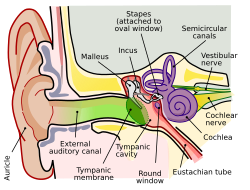Intrinsic_muscles_of_external_ear
Outer ear
Outer part of ear
The outer ear, external ear, or auris externa is the external part of the ear, which consists of the auricle (also pinna) and the ear canal.[1] It gathers sound energy and focuses it on the eardrum (tympanic membrane).
This article has multiple issues. Please help improve it or discuss these issues on the talk page. (Learn how and when to remove these template messages)
|

